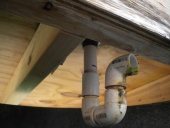Hello Michael,
The one challenge with "in ground" impoundments for
aquaculture is the dependance on pumps to transfer and move water. If there is some reasonable topography to the project site, gravity, and siphon methods, can be put to really good use in draining and transferring water; then more can be done with less pumps. There are "bicycle" style pumps and related hand pumps, yet these are a lot of work, so be prepared.
Now following your original plan (you may have to play with the volume geometry a bit) going down 24 inches may yield enough earth to "berm" the takes to achieve your 30" or perhaps more.
Plastics as liners are considered "transient" and not permanent methods. Even EPDMs have a limited service life span compared to gleying methods for clay/lime based pond sealing methods. Most "fish farming" (organic or otherwise) is done with in ground ponds with clay bottoms and sides. There are countless ancient methods from both Europe and Asia, the latter being the oldest, that formulate gleying methods of animal manure, botanicals/cellulose and/or lime/clay matrix.
gleying methods
Sealing Fish Ponds
I would also note again that wood lined vertical "tanking" or sides is very effective as wood only rots above waterline and not below. Wood lined tanking gives shearer sides to the small ponds (a.k.a rearing pens) there by making the ergonomics and layout of the impoundments more space efficient.
I would also look into the augmentation/amendment to the clays with "hot lime" to create a stronger and more watertight seal to the gleying layers. I can also share that I have had some success in the past making my very first layer within the "dry fresh dig" with 10 layers minimum (30 or more is better) from old newspaper that is then wetted with a "rice soup" or other natural gluing agent. This is always done before ever using a "lining method" and seems to extend the lifespan for linings limited durability. Either way, the "paper layer" goes on first for small ponds and does a lot of good.
Good luck, and post picture please of your project so other can learn from what you are doing!!.....

j






